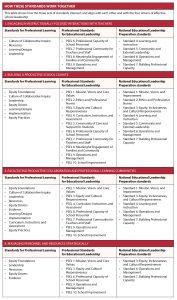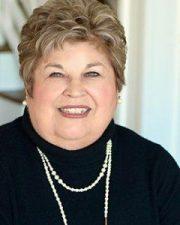FOCUS
Aligned standards keep students, teachers, and leaders moving in the same direction
By Jackie Owens Wilson
Categories: Leadership, School leadership, Standards for Professional LearningJune 2022
In the many roles I have filled as an education leader, standards have always played an influential part, guiding my decisions and serving as a road map to the destination I am trying to reach. While serving as a principal, a leadership coach, and the director of a center that supports school leaders, my goal has always been to ensure that all areas of my work are focused on the learning, achievement, development, and well-being of each student. Aligning with standards is essential for achieving that goal because the journey is complex and multidimensional, and it takes a clear, collaborative instructional focus to succeed.
To ensure we’re all moving in the right direction, we must align standards for students’ expected knowledge and skills, teachers’ practices, and leaders’ actions and processes. Standards for Professional Learning are a key part of that alignment because they shape the preparation and support that ensure teachers and leaders fulfill the expectations.
When educators engage in professional learning that is standards-based and led by an administrator who engaged in a standards-aligned preparation program and works in a state that has adopted standards for school leadership, there is greater potential for everyone in the system to develop the beliefs, values, knowledge, and skills to improve their practices and, in turn, student results.
For school leaders, the National Educational Leadership Preparation standards and the Professional Standards for Educational Leaders are essential links in creating a chain of aligned knowledge and support. When they are integrated with Standards for Professional Learning, the whole chain is stronger, and the result is improved teaching and learning.
As a member of Learning Forward’s Standards Advisory Council, I saw how the revised standards were developed with those linkages in mind (see box below). Here I offer a window into that alignment process to help other school leaders create a coherent, systemic approach to implementing standards.
Professional standards for school leadership and professional learning
The National Policy Board for Educational Administration (NPBEA) is a national alliance of major membership organizations committed to the advancement of school and school system leadership. Member organizations represent the educational administration profession and collaborate to improve the preparation and practice of educational leaders at all levels.
The organization’s mission is to lead standards-based and research-informed policy, preparation, and practice for school and school system leaders. The Professional Standards for Educational Leaders and the National Educational Leadership Preparation standards reside with the policy board.
The Professional Standards for Educational Leaders provide guideposts that help school leaders make a difference every day in the learning and well-being of students (NPBEA, 2015). Grounded in current research and the real-life experiences of education leaders, they articulate the leadership that schools need and students deserve.
They are student-centric, outlining foundational principles of leadership to guide the practice of education leaders so they can move the needle on student learning and achieve more equitable outcomes. The standards were designed to ensure that education leaders are ready to meet challenges of the job today and in the future as education, schools, and society continue to transform.
The standards are foundational and provide direction for my work in schools. As an education leader, I must have a vision and goals for the work I want to accomplish. I must make decisions that are inclusive and ethical. The Professional Standards for Educational Leaders provide guidance on these aspects of the work.
I also know that I cannot do the work independently. I need talented individuals to help me with the various components of school improvement. This often requires new knowledge and skills for the entire team of educators, and these standards guide how leaders can work with and support their team’s development.
The National Educational Leadership Preparation standards, aligned to the Professional Standards for Educational Leaders, serve a different but related purpose, and provide greater specificity around performance expectations for beginning-level building and district leaders (NPBEA, 2018). Whereas the Professional Standards for Educational Leaders define educational leadership broadly, the National Educational Leadership Preparation standards specify what novice leaders and preparation program graduates should know and be able to do after completing a high-quality educational leadership preparation program.
The National Educational Leadership Preparation standards were developed with building and district leaders in mind and are used to review educational leadership programs by the National Educational Leadership Preparation Specialty Professional Association of the Council for the Accreditation of Educator Preparation. There is one set of National Educational Leadership Preparation standards for candidates preparing to become building-level leaders and a second set of standards for candidates seeking to become district-level leaders.
In my work with novice assistant principals, it is important to know that the preparation program where they recently completed their administrative certification aligned its curriculum and clinical requirements to the National Educational Leadership Preparation standards. This knowledge gives me confidence that these principals have a foundational understanding of and skills in the areas most relevant for a beginning assistant principal or principal.
Learning Forward’s Standards for Professional Learning provide specificity on how education leaders in many different roles — including building-level leaders — can develop professional learning communities, commit to a specific learning design, use student data to inform instructional practices, allocate resources in an equitable manner, and improve curriculum, instruction, and assessment practices.
As an instructional leader, I have depended on Learning Forward’s Standards for Professional Learning to provide a framework for my work with teachers and support staff that aligns with leadership goals and standards. And in the professional development center I lead at the University of Delaware, the standards ensure that the professional learning experiences we provide to educators are based on effective, research-informed practices for professional growth and development.
Using professional learning communities, learning designs, and data inquiry processes are major steps to interact with teachers and build a collaborative school and district culture that is conducive to teaching and learning.
These three sets of standards were not designed to work independently, but in concert with one another. A principal who has been prepared in a standards-aligned program (National Educational Leadership Preparation) and works in a school system where their performance evaluation, professional learning, and support are aligned to professional school leadership standards (Professional Standards for Educational Leaders), and who applies Standards of Professional Learning (Learning Forward) to improve educator effectiveness and results for all students has a great probability of success in leading school improvement.
A crosswalk of leadership and professional learning standards
To understand how Standards for Professional Learning, National Educational Leadership Preparation standards, and Professional Standards for Educational Leaders work together, I find it helpful to view a crosswalk of the specific standards from each. I have organized this crosswalk based on a set of leadership drivers identified in an influential study commissioned by The Wallace Foundation, How Principals Affect Students and Schools: A Systematic Synthesis of Two Decades of Research (Grissom et al., 2021). This influential report found that four types of skills, expertise, and leadership behaviors drive the principal’s impact on the school:
Engaging in instructionally focused interactions with teachers. This includes forms of engagement with teachers that center on instructional practice, such as teacher evaluation, instructional coaching, and the establishment of a data-driven, schoolwide instructional programs to facilitate such interactions.
Building a productive school climate. Practices in this category encourage a school environment marked by trust, efficacy, teamwork, engagement with data, organizational learning, and continuous improvement.
Facilitating productive collaboration and professional learning communities. Strategies that promote collaboration have teachers working together authentically, along with systems of support, to improve practice and enhance student learning.
Managing personnel and resources strategically. This includes strategic staffing and thoughtful allocation of other resources.
The table below shows how the three sets of standards intersect and align with each other and with the four drivers of effective school leadership.

How leaders can use the standards
It’s important to remember that professional standards provide the direction but not a how-to manual for school leaders. They tell me what work is important based on empirical research and feedback from practitioners, but they do not tell me how or when to do the work or warn me of the barriers I will confront.
It is up to individual leaders to use the standards to guide decision-making based on our experience, the context of the school and district, and the specific needs and expertise of our teams. Implementing standards is like using a GPS device: It will tell the user how to get to your destination, but you choose whether to take the fast or slow route, whether to pay or avoid tolls, and how to navigate around detours.
The decisions we make and the work we do in schools are hard. There are no quick fixes, easy solutions, or magic formulas that we stir up to solve the complex problems we face. But we have a greater chance of success if leaders and organizations work together on these challenges and share resources. Shared work leads to creativity, problem-solving, and improved processes. When I have participated in collaborative projects, I have found myself more motivated and committed to the work because I collaborated with partners who were equally as enthusiastic and focused on results and more open to finding innovative and effective solutions.
This was true in the process of developing Standards for Professional Learning, and it will be true in implementing them. Education leaders should work together to decide how to apply the professional learning and leadership standards in ways that complement one another. Finding ways to align and strengthen our system is a continuous improvement process that requires all of us to commit to collaboration in the service of students.
A system that is aligned to professional standards provides educators with a research foundation for the work in schools. National Educational Leadership Preparation standards inform preparation, Professional Standards for Educational Leaders guide school leader practices, and Standards for Professional Learning provide direction for developing and growing the instructional capacity of staff. It is this alignment that provides the direction for leadership practices and professional learning to work in harmony.
Down load pdf here.
Standards for Professional Learning revision process
The revision of Learning Forward’s Standards for Professional Learning has been a collaborative process with national and international representation. As a member of the Standards Advisory Council, I was excited by the process, which included opportunities for collaboration, discussion, and consensus building on topics related to the research and best practices associated with professional learning.
Thinking about how we grow and develop our professional practice to better serve students was at the center of every discussion. There were opportunities to think about the standards from various perspectives, including how the standards might be interpreted by educators in a school, district, or state or national policy perspective.
I found myself taking off my national policy hat and thinking like a teacher participating in a professional learning community or my principal cap when thinking about the professional learning my staff would need to lead classroom instruction that is culturally responsive. The revision of these standards reminded me of how important Standards for Professional Learning are to all educators.
References
Grissom, J.A., Egalite, A.J., & Lindsay, C.A. (2021). How principals affect students and schools: A systematic synthesis of two decades of research. The Wallace Foundation. www.wallacefoundation.org/principalsynthesis
National Policy Board for Educational Administration. (2015). Professional Standards for Educational Leaders. Author. www.npbea.org/wp-content/uploads/2017/06/Professional-Standards-for-Educational-Leaders_2015.pdf
National Policy Board for Educational Administration. (2018). National Educational Leadership Preparation (NELP) program standards – building level. www.npbea.org/wp-content/uploads/2018/11/NELP-Building-Standards.pdf

Jackie Owens Wilson (jowilson@udel.edu) has 45 years of experience in K-20 education through multiple levels of the education system, with expertise in leadership, coaching, standards, and professional learning. She currently serves as assistant professor in the School of Education at the University of Delaware and executive director of the National Policy Board for Educational Administration. Wilson and co-author Gary Bloom just released a book with Corwin Press titled Blended Coaching: Skills and Strategies to Support the Development and Supervision of Professional Educators.
Categories: Leadership, School leadership, Standards for Professional Learning
Recent Issues
WHERE TECHNOLOGY CAN TAKE US
April 2024
Technology is both a topic and a tool for professional learning. This...
EVALUATING PROFESSIONAL LEARNING
February 2024
How do you know your professional learning is working? This issue digs...
TAKING THE NEXT STEP
December 2023
Professional learning can open up new roles and challenges and help...
REACHING ALL LEARNERS
October 2023
Both special education and general education teachers need support to help...










